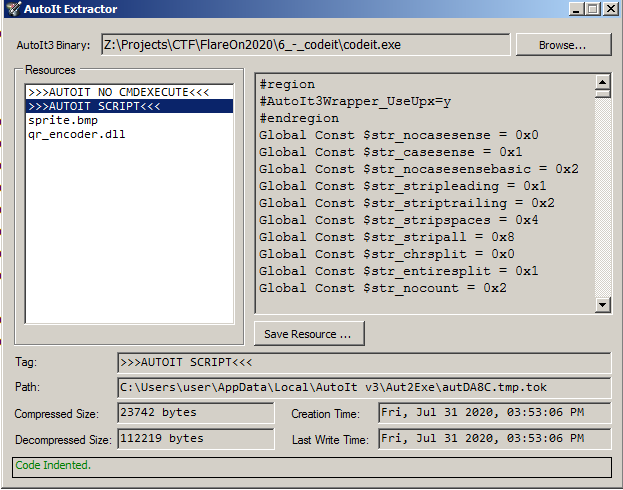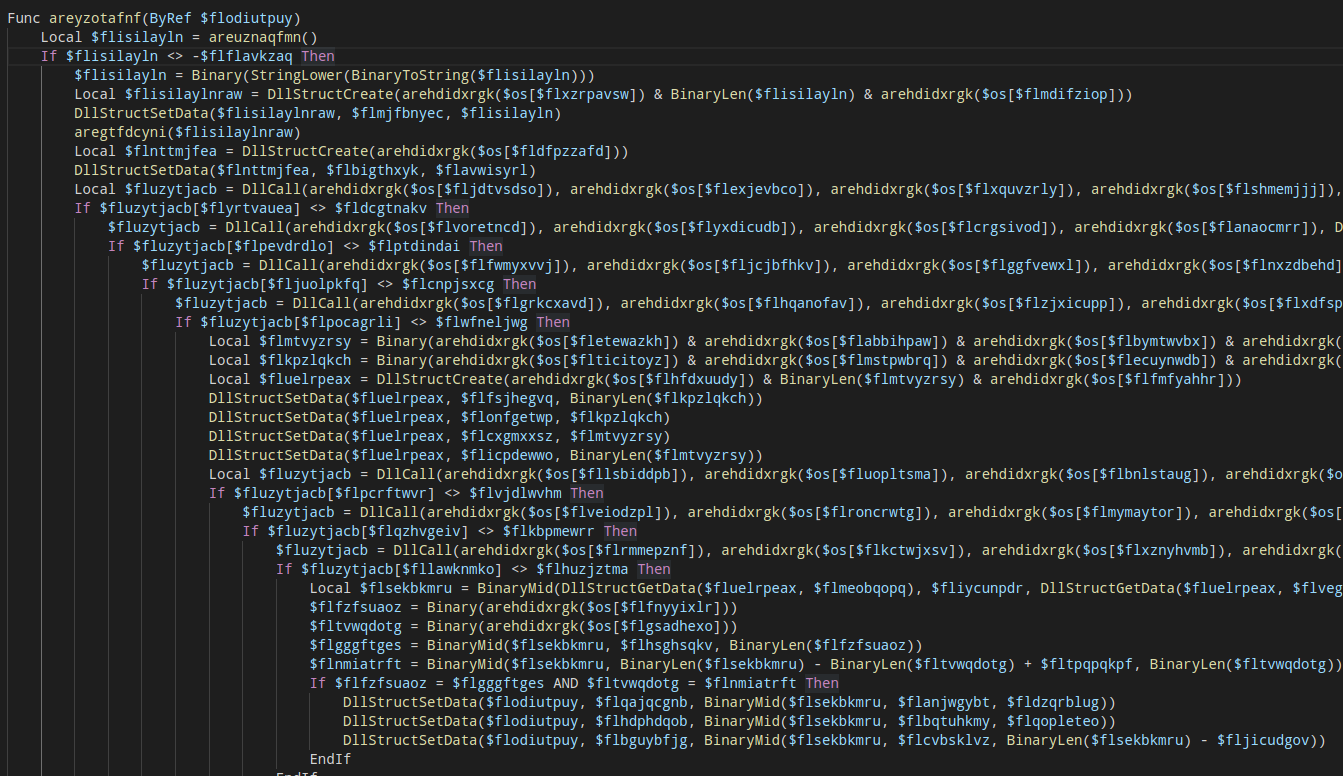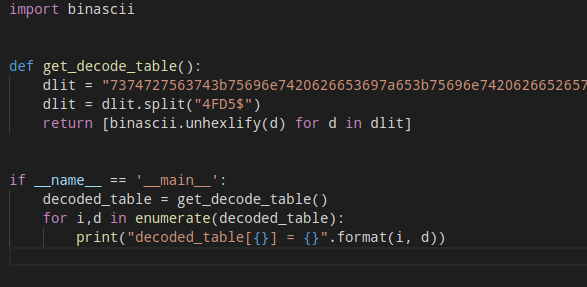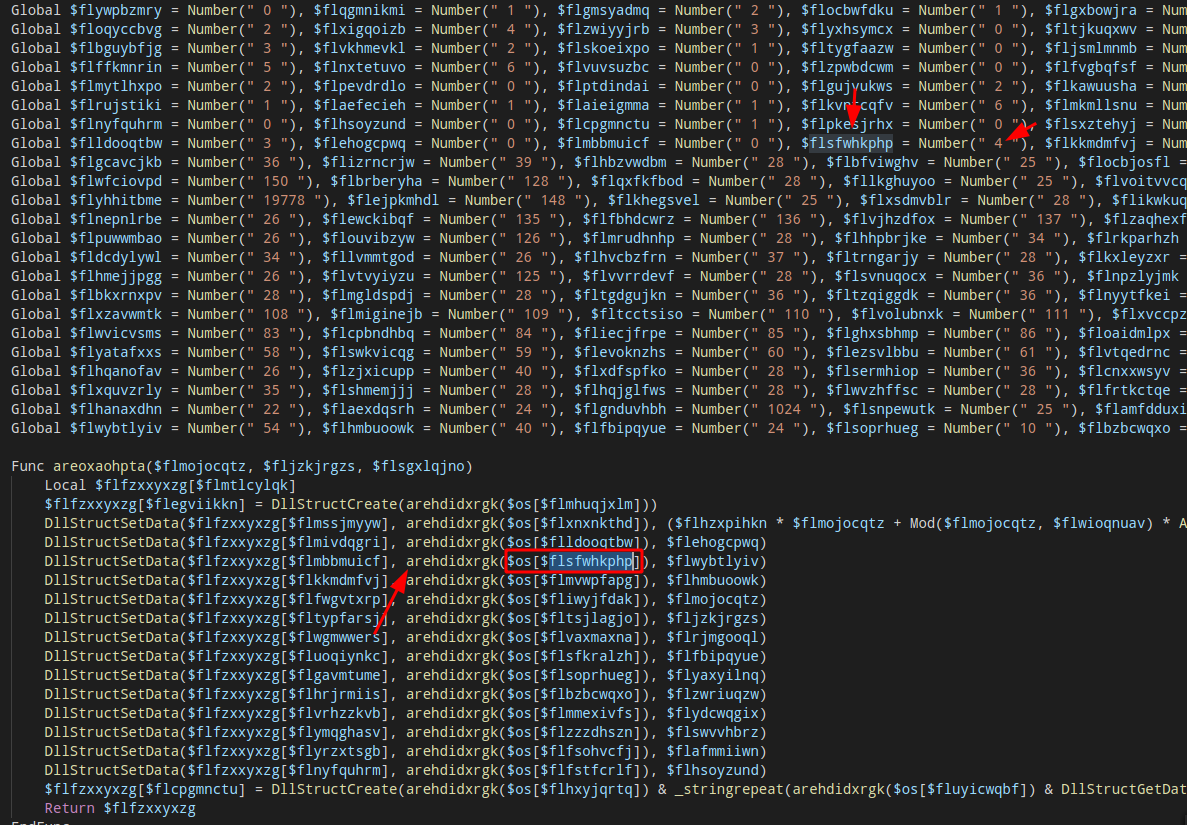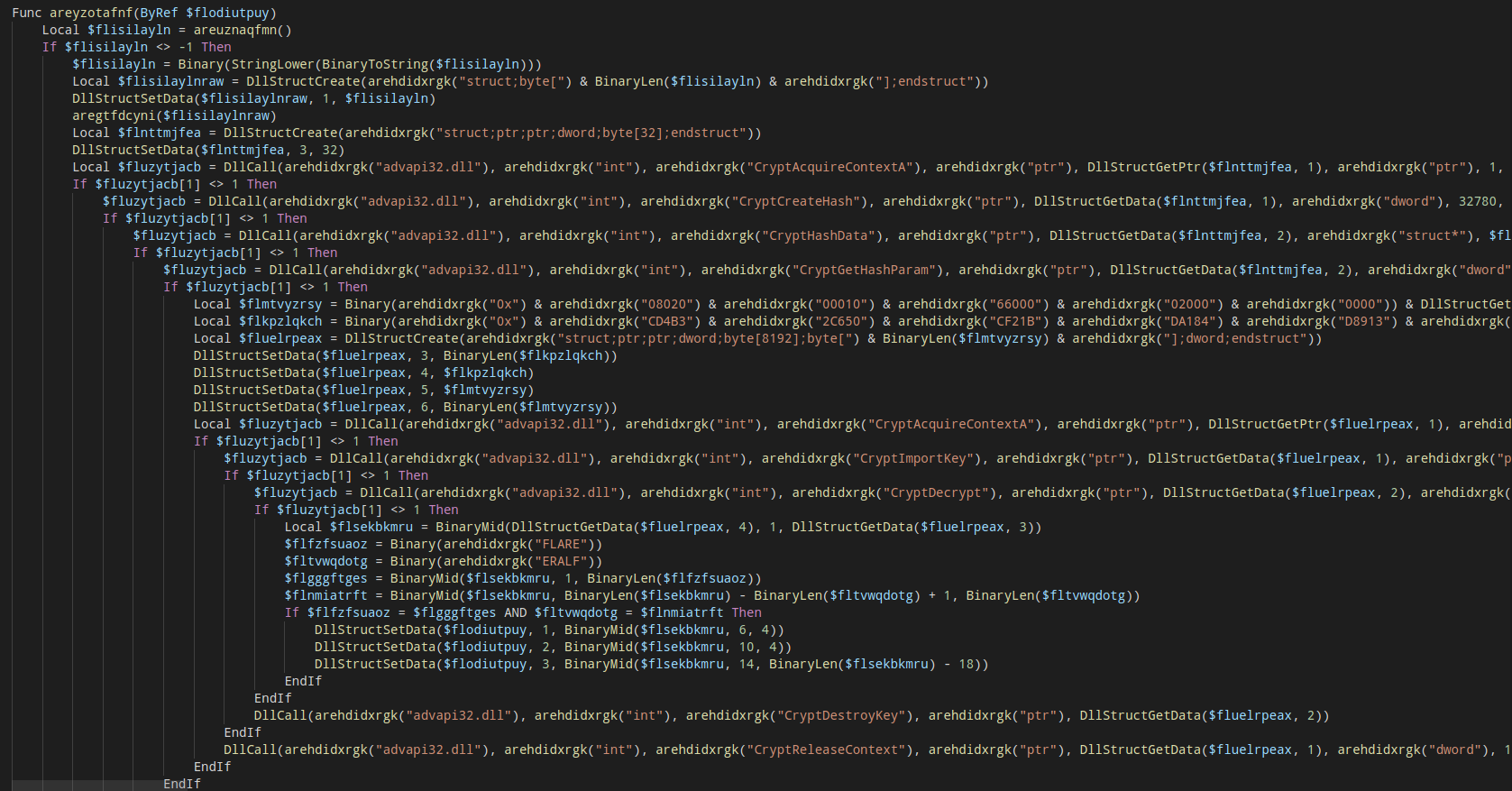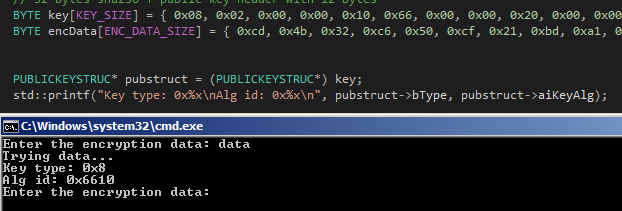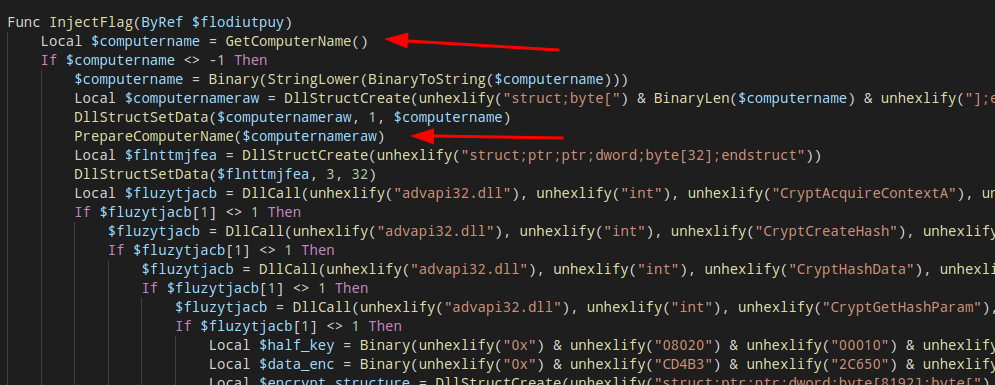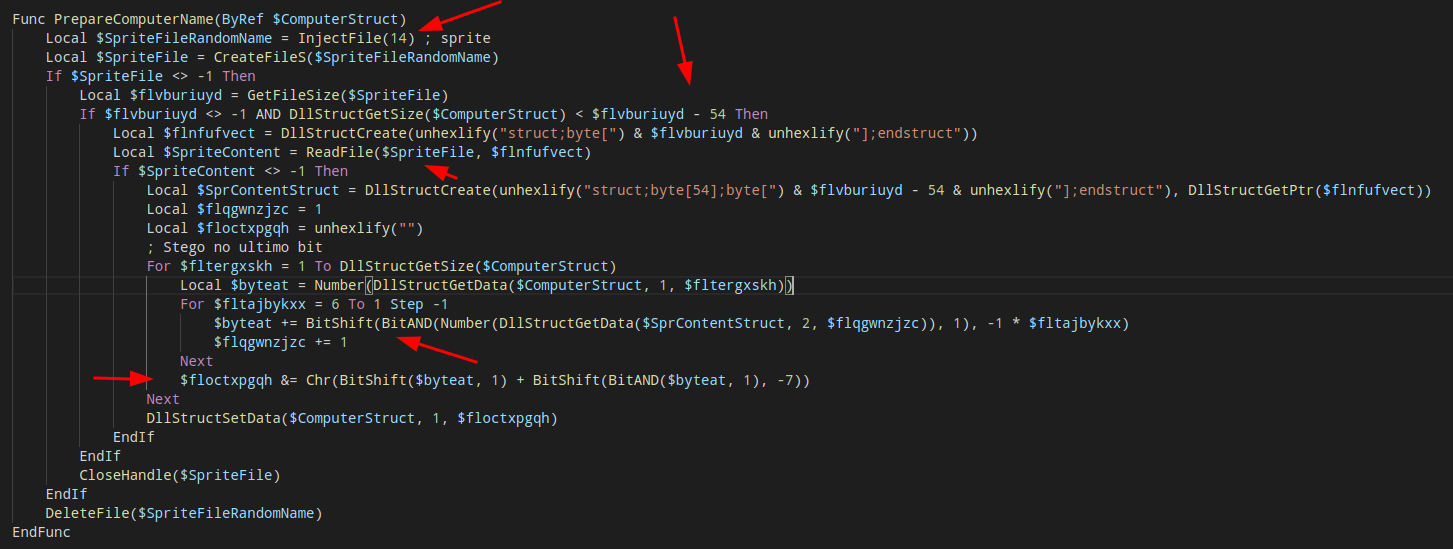The 7th challenge of Flare-On CTF, give to us a QR code generator software that are fully obfuscated, the fun part of this challenge was interpret, analyse and deobfuscate core components of the software and then, make it give us the flag.
Why this is useful ?
Obfuscated script
In a real world scenario, malware using scripting language often came obfuscated and using a known languange, this challenge has a AutoIT software that are compressed and obfuscated, what makes the normal script analysis even harder.
Encryption functions and Win32 calls
This challenge also explores how software often use Win32 functions by creating structs from the scripting interface, this can increase the power of the script engine even more. In this one, almost all Win32 api calls are from the WinCrypto, this shows to us how can some obfuscated malware can use the encryption functions from Windows for bad porpuse.
Some kind of steganography
This challenge also explores how can we hide messages in images like Bitmap using the LSB technique, with that the malware can literally have passwords or hidden commands in plain sight that are decoded in runtime.
CTF
Check out, how this all behave:
Message:
Reverse engineer this little compiled script to figure out what you need to do to make it give you the flag (as a QR code).
So, in this challenge we must understand how this QR code generator works and be able to make it replace the content with the flag.
Recon
Before I even started this challenge, by the name Codeit I imagined that has something to do with AutoIT, and guess so ? It has everything to do with AutoIT.
The file itself is compressed with UPX
file codeit.exe
codeit.exe: PE32 executable (GUI) Intel 80386, for MS Windows, UPX compressed
But, even this compressed file contain some data that indicate that we are dealing with an AutoIT compiled script,
1
2
3
4
>> strings codeit.exe | grep AU3
$pAU3
H}AU3!EA06M
AU3!EA06T
AU3!… it’s like the magic number of compiled Autoit scripts, that has .au3 extension.
Running
So, the program works by receiving a text and creating a valid/authentic QR Code
The first software has the initial screen and the second I put a word and generate a QR Code, the software I was using to read this images (that I printed) is qtqr.
So, at first look the software only do that.
AutoIT extraction
The au3 script inside the autoit executable are compressed in the resource section, together with all the project files itself, I will use AutoITExtractor to retrieve all files associated with this project.
I extracted every piece of this project, sprite.bmp (The initial image), qr_encoder.dll a library that create qr codes, created by Nayuki and the script itself.
The pain and the cure of obfuscation
The entire script is obfuscated, so it’s almost impossible to read without a little strugle, but let’s dig down into this obfuscation technique.
The decode table
Before the program logic even starts, there is a global decode table that are created, denoted by the variable $os, and the string values are encoded like:
In order to pick all the program strings we just need to copy all this data and split by the word 4FD5$, I created a python decoder for that:
The idea here it’s very simple, I just split the string and transformed this string in hex representation in his really value, that way I created the same table used by the script, and now I can see the real strings.
Some of the strings are below:
1
2
3
4
5
6
7
8
9
10
11
12
13
14
15
16
17
18
19
20
21
22
...
decoded_table[24] = b'kernel32.dll'
decoded_table[25] = b'int'
decoded_table[26] = b'GetComputerNameA'
decoded_table[27] = b'ptr'
decoded_table[28] = b'CodeIt Plus!'
decoded_table[29] = b'struct;byte['
decoded_table[30] = b'];endstruct'
decoded_table[31] = b'struct;byte[54];byte['
decoded_table[32] = b'struct;ptr;ptr;dword;byte[32];endstruct'
decoded_table[33] = b'advapi32.dll'
decoded_table[34] = b'CryptAcquireContextA'
decoded_table[35] = b'dword'
decoded_table[36] = b'CryptCreateHash'
decoded_table[37] = b'CryptHashData'
decoded_table[38] = b'struct*'
decoded_table[39] = b'CryptGetHashParam'
decoded_table[40] = b'0x'
decoded_table[41] = b'08020'
decoded_table[42] = b'00010'
decoded_table[43] = b'66000
...
But I don’t stopped there, I need to at least make the code readable.
The obfuscator algorithm
So the way that obfuscator is:
- It create a global decode table
- Its created a bunch of variable to represente numbers
- When some variable wants the string it will call the decode table with the index of the string
- The value will be send to a function that will do the job of unhexlify function
Example:
The function arehdidxrgk is the function that will decode the string, in this case, it’s looking at the position 4 in the decode table, obs: In autoit/vbs the index starts at 1, so in this case, it’s looking the value ‘biSize’.
The deobfuscator algorithm
So, how I managed to defeat this obfuscation ? Doing all this at once!
- Create a regex rule to found all the Number(“ \d+ “) ocurrences
- If it’s the number is lower than the size of my decode table I save the variable name with the value
- Else I just hold the number value and the variable, because sometimes it wants just the number
- Then replace all $os[] by the value itself.
Deobfuscator code
1
2
3
4
5
6
7
8
9
10
11
12
13
14
15
16
17
18
19
20
21
22
23
24
25
26
27
28
29
30
31
32
33
34
35
36
37
38
39
40
41
42
43
44
def deobfuscate_content(content, decode_table):
index_rule = r'Number\(\" \d+ \"\)'
number_table = re.finditer(index_rule, content)
decode_table_len = len(decode_table)
tokens = {}
# Find and classify tokens
for number in number_table:
real_number = int(number.group().split("\"")[1])
if real_number != 0:
real_number -= 1
variable_name = content[number.start()-14:number.start()-3]
if real_number >= decode_table_len:
tokens[variable_name] = {
'real_value': '',
'number': str(real_number+1),
'is_encoded': False
}
continue
real_value = decode_table[real_number]
tokens[variable_name] = {
'real_value': real_value.decode(),
'number': str(real_number+1),
'is_encoded': True
}
# Replace the values
for token, value in tokens.items():
if value['is_encoded']: # If has a value in decode_table
replace_var = "$os[{}]".format(token)
content = content.replace(replace_var, '\"{}\"'.format(value['real_value']))
content = content.replace(token, value['number'])
return content
The final code looks like:
Now, let’s start the real challenge, this is far from finish.
Windows crypto functions
You already have noticed that has come calls to CryptAcquireContextA and CryptDecrypt, in order to AutoIT call this native functions it will use a special call called DllCall and the values must be created as an struct in memory with DllStructCreate, this structures holds the same memory representation as this function will received if was called by the native code.
I recreated all this encryption part in C++, and it will be very easy to show what is happening here, because I already did all the dirty work to read each value in the struct passed and rebuild exactly the same call, if you don’t have windows SDK, you can follow all this using the wincrypt.h from wine,so let’s in parts:
CryptAcquireContextA starts a new “encryption session” in Windows, using the handler we can access the crypto features, and this function must be called with the correct params that we want in our encryption.
1
2
3
4
5
6
7
BOOL CryptAcquireContextA(
HCRYPTPROV *phProv,
LPCSTR szContainer,
LPCSTR szProvider,
DWORD dwProvType,
DWORD dwFlags
);
1
2
3
4
HCRYPTPROV cryptContext;
if (CryptAcquireContext(&cryptContext, NULL, NULL, PROV_RSA_AES, 4026531840)) {
...
}
So this will start a session that will use AES for RSA keys.
CryptCreateHash will start a new hash algorithm using the previous context, in this case:
1
2
3
4
5
6
7
BOOL CryptCreateHash(
HCRYPTPROV hProv,
ALG_ID Algid,
HCRYPTKEY hKey,
DWORD dwFlags,
HCRYPTHASH *phHash
);
1
2
3
4
5
6
7
HCRYPTHASH hash;
CryptCreateHash(
cryptContext,
CALG_SHA_256, // 32780
NULL,
NULL,
&hash);
Now it will use CryptHashData to hash the data from flisilaylnraw variable (I will back in this names too) and will retrieve the results with CryptGetHashParam.
1
2
3
4
5
6
BOOL CryptHashData(
HCRYPTHASH hHash,
const BYTE *pbData,
DWORD dwDataLen,
DWORD dwFlags
);
1
2
3
4
5
6
7
BOOL CryptGetHashParam(
HCRYPTHASH hHash,
DWORD dwParam,
BYTE *pbData,
DWORD *pdwDataLen,
DWORD dwFlags
);
1
2
3
if (CryptHashData(hash, input, size, NULL) && CryptGetHashParam(hash, HP_HASHVAL, hashedData, &hashSize, NULL)){
...
}
Now, it will concat this value with another hex value:
1
0x08, 0x02, 0x00, 0x00, 0x10, 0x66, 0x00, 0x00, 0x20, 0x00, 0x00, 0x00 + <hashed_data>
This value, is actually a PUBLICKEYSTRUC that come when you export you created key by using CryptExportKey function.
So, there is a bunch of encrypted data in this part, and the created key will be imported with CryptImportKey function and later this encrypted data will be decrypted by CryptDecrypt, if the decryption is sucessfully, our flag will be placed in our QRCode.
1
2
3
4
5
6
7
8
BOOL CryptImportKey(
HCRYPTPROV hProv,
const BYTE *pbData,
DWORD dwDataLen,
HCRYPTKEY hPubKey,
DWORD dwFlags,
HCRYPTKEY *phKey
);
1
2
3
4
5
6
7
8
BOOL CryptDecrypt(
HCRYPTKEY hKey,
HCRYPTHASH hHash,
BOOL Final,
DWORD dwFlags,
BYTE *pbData,
DWORD *pdwDataLen
);
So, I created an entire decrypt system based in this algorithm, but guess so ? It’s not the way to beat this challenge, but is fundamental to understand that part.
The unused brute force function
1
2
3
4
5
6
7
8
9
10
11
12
13
14
15
16
17
18
19
20
21
22
23
24
25
26
27
28
29
30
31
32
33
34
35
36
37
38
39
40
41
42
43
44
45
46
47
48
49
50
51
52
53
54
55
56
57
58
59
60
61
62
63
64
65
66
67
68
69
70
71
72
73
74
75
76
77
bool decrypt(BYTE* candidate_password, int size)
{
bool ok = false;
HCRYPTPROV cryptContext;
if (CryptAcquireContext(&cryptContext, NULL, NULL, PROV_RSA_AES, 4026531840)) {
/// Context ok
// 32 bytes sha256 + public key header with 12 bytes
BYTE key[KEY_SIZE] = { 0x08, 0x02, 0x00, 0x00, 0x10, 0x66, 0x00, 0x00, 0x20, 0x00, 0x00, 0x00, }; // Partial key
BYTE encData[ENC_DATA_SIZE] = { 0xcd, 0x4b, 0x32, 0xc6, 0x50, 0xcf, 0x21, 0xbd, 0xa1, 0x84, 0xd8, 0x91, 0x3e, 0x6f, 0x92, 0xa, 0x37, 0xa4, 0xf3, 0x96, 0x37, 0x36, 0xc0, 0x42, 0xc4, 0x59, 0xea, 0x7, 0xb7, 0x9e, 0xa4, 0x43, 0xff, 0xd1, 0x89, 0x8b, 0xae, 0x49, 0xb1, 0x15, 0xf6, 0xcb, 0x1e, 0x2a, 0x7c, 0x1a, 0xb3, 0xc4, 0xc2, 0x56, 0x12, 0xa5, 0x19, 0x3, 0x5f, 0x18, 0xfb, 0x3b, 0x17, 0x52, 0x8b, 0x3a, 0xec, 0xaf, 0x3d, 0x48, 0xe, 0x98, 0xbf, 0x8a, 0x63, 0x5d, 0xaf, 0x97, 0x4e, 0x0, 0x13, 0x53, 0x5d, 0x23, 0x1e, 0x4b, 0x75, 0xb2, 0xc3, 0x8b, 0x80, 0x4c, 0x7a, 0xe4, 0xd2, 0x66, 0xa3, 0x7b, 0x36, 0xf2, 0xc5, 0x55, 0xbf, 0x3a, 0x9e, 0xa6, 0xa5, 0x8b, 0xc8, 0xf9, 0x6, 0xcc, 0x66, 0x5e, 0xae, 0x2c, 0xe6, 0xf, 0x2c, 0xde, 0x38, 0xfd, 0x30, 0x26, 0x9c, 0xc4, 0xce, 0x5b, 0xb0, 0x90, 0x47, 0x2f, 0xf9, 0xbd, 0x26, 0xf9, 0x11, 0x9b, 0x8c, 0x48, 0x4f, 0xe6, 0x9e, 0xb9, 0x34, 0xf4, 0x3f, 0xee, 0xde, 0xdc, 0xeb, 0xa7, 0x91, 0x46, 0x8, 0x19, 0xfb, 0x21, 0xf1, 0xf, 0x83, 0x2b, 0x2a, 0x5d, 0x4d, 0x77, 0x2d, 0xb1, 0x2c, 0x3b, 0xed, 0x94, 0x7f, 0x6f, 0x70, 0x6a, 0xe4, 0x41, 0x1a, 0x52, };
PUBLICKEYSTRUC* pubstruct = (PUBLICKEYSTRUC*) key;
std::printf("Key type: 0x%x\nAlg id: 0x%x\n", pubstruct->bType, pubstruct->aiKeyAlg);
HCRYPTHASH hash;
CryptCreateHash(
cryptContext,
CALG_SHA_256, // 32780
NULL,
NULL,
&hash);
// Hash created
const BYTE* userinput = (const BYTE*)candidate_password;
BYTE hashedData[32];
DWORD hashSize;
// puts("Hashing value...");
if (CryptHashData(hash, userinput, size, NULL) && CryptGetHashParam(hash, HP_HASHVAL, hashedData, &hashSize, NULL)){
// sha256 hash
// puts("Building the candidate private key...");
for (auto i = 0; i < hashSize; ++i) {
key[INITIAL_SIZE + i] = hashedData[i];
}
// Create
HCRYPTPROV decryptContext;
HCRYPTKEY privKey;
//puts("Importing key...");
if (CryptAcquireContext(&decryptContext, NULL, NULL, 24, 4026531840) && CryptImportKey(decryptContext, key, KEY_SIZE, NULL, NULL, &privKey)) {
puts("[+] Key imported! [+]\nStarting decryption...");
for (auto i = 0; i < KEY_SIZE; ++i) {
printf("%x", key[i]);
}
DWORD data_len;
if (CryptDecrypt(privKey, hash, NULL, TRUE, encData, &data_len)) {
puts("[+] Decrypted!! [+]");
printf("Hex value: ");
for (auto i = 0; i < ENC_DATA_SIZE; ++i) {
printf("%x", encData[i]);
}
printf("Char value: ");
for (auto i = 0; i < ENC_DATA_SIZE; ++i) {
printf("%c", encData[i]);
}
printf("Key used: ");
for (auto i = 0; i < KEY_SIZE; ++i) {
printf("%x", key[i]);
}
ok = true;
}
printf("\n%d\n", GetLastError());
CryptDestroyKey(privKey);
CryptDestroyHash(hash);
}
}
}
return ok;
}
The computer name function
Later on I realized that my input was never sent to the encryption part, but was another value, this value was my computer name that the script gets my calling GetComputerNameA function, then the name of my computer is passed to a function that will do a lot of operation up my computer name bytes and just after that, this decryption routine is called.
obs: At this point I already renamed a lot of functions name, so it’s very clean righ now
So, here my computer name is saved and then passed to a function that a called PrepareComputerName
PrepareComputerName function
The key to beat this challenge is here, the script will load the sprite.bmp image and will see if it has some content after 54 bytes (After the bitmap header), and will start to loop in each of our computer name value and do the following steps:
Inside bitmap loop
- Read 6 bytes from the bitmap file
- For each byte it will check if has a Least significant bit
- If has, it will be shift left this bit by the loop number it are righ now
- It will sum that to the current variable name
Out bitmap loop:
- It will remove the LSB
- Then will sum this value by 128 (1«7)
What the **ck is this ? I don’t picke-up 100% of this encoding technique, but the important part is, the key is actually encoded here, if we just ignore the fact that we are increasing the computer name byte and just get the encoded value in the bitmap, we will be able to recover the key. Because this function guarante that if the computername is wrong it will be changed by the encode schema.
I rewritten this routine to give us the key, and for better understanding:
1
2
3
4
5
6
7
8
9
10
11
12
13
14
15
16
17
18
19
20
21
22
23
24
25
26
27
28
29
30
31
32
33
34
35
36
37
38
39
import sys
import hashlib
sprite_content = open("sprite.bmp", "rb").read()
hostname = [ord(x) for x in sys.argv[1].lower()]
sprite_content = sprite_content[54:] # Remove header
out = ""
count = 0
extracted = ""
flag = []
for i in range(len(hostname)):
number_at = hostname[i]
real_value = 0
print("Picking {} ".format(number_at))
for j in range(6, -1, -1):
f = (sprite_content[count] & 1) << j
print("({} & 1) << {} = {}".format(sprite_content[count], j, f))
number_at += f
real_value += f
count += 1
flag.append(chr(real_value))
print("Result {}".format(number_at))
sum_lsb = (number_at >> 1) + ((number_at & 1) << 7)
print("Appling ({0} >> 1) + (({0} & 1)) << 7) = {1}".format(number_at, sum_lsb))
out += chr(sum_lsb)
print(''.join(flag))
print(out)
print(' '.join([ hex(ord(o)) for o in out ]))
print(len(out))
If will run with any input and the bitmap, we will get the encoded value + the operation result value:
1
2
3
4
5
6
7
8
9
10
11
12
13
14
15
16
17
18
19
20
21
22
23
24
25
python3 decode.py THISISAVERYGO
Picking 116
(255 & 1) << 6 = 64
(255 & 1) << 5 = 32
(254 & 1) << 4 = 0
(254 & 1) << 3 = 0
(254 & 1) << 2 = 0
(254 & 1) << 1 = 0
(255 & 1) << 0 = 1
Result 213
Appling (213 >> 1) + ((213 & 1)) << 7) = 234
Picking 104
(255 & 1) << 6 = 64
(255 & 1) << 5 = 32
(255 & 1) << 4 = 16
(254 & 1) << 3 = 0
(255 & 1) << 2 = 4
(254 & 1) << 1 = 0
(255 & 1) << 0 = 1
Result 221
....
aut01tfan1999
êîîÑMóãëéÑYPT
0xea 0xee 0xee 0xd1 0x4d 0xf3 0xe3 0xeb 0xe9 0xd1 0x59 0x50 0x54
13
The encoded value is aut01tfan1999 if we pass this value as the input of this function, it will get the same as output:
1
2
3
4
5
6
...
Result 114
Appling (114 >> 1) + ((114 & 1)) << 7) = 57
aut01tfan1999
aut01tfan1999
0x61 0x75 0x74 0x30 0x31 0x74 0x66 0x61 0x6e 0x31 0x39 0x39 0x39
Finally, the flag
Nice, we can now open the project in AutoIT editor and change the computer name or change our computer name and reboot.
That one, was very hard to pick-up and I did a LOT of research in many topics, the resolution was far from what I was looking at the beginning, but still a very nice and amazing challenge!

